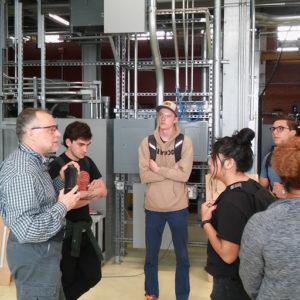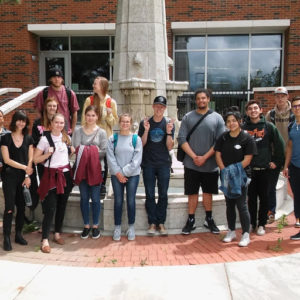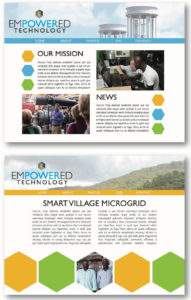Students in a graphic design class at Colorado State University got some real-world experience working for a client when they took on a marketing job for the CSU Energy Institute’s rural electrification project in Rwanda.
And the experience led to an internship for one art student who has had to gain a better understanding of science and sustainability to present concepts visually.

John Gravdahl, a professor in the Department of Art and Art History, made the marketing project for the Energy Institute the focus of his intensive four-week course, “Typography and Design Systems,” last summer. The 15 students, who were in class for at least five hours of every day that month, were charged with not only coming up with a better name for the rural electrification project, but also designing logos, infographics and other assets for signage, print materials and the web.
“This project had everything I wanted my students to get exposed to,” Gravdahl said. “It really means something to have a real client, to have that person across the table.”
The Energy Institute’s project in Rwanda involves helping the country expand its population’s access to electricity. The Rwandan government estimates that only about 20 percent of the country has electricity; its goal is to provide electrical power to the entire population by 2024.
Running power lines from a national electric grid is not only costly but would provide electricity to only about half of the population. Instead, the Rwandan government is pursuing smaller, community-based microgrids and small household systems that generate electricity on-site and distribute solar power to the end consumers. The Energy Institute, in collaboration with the University of Rwanda and energy startup MeshPower, is helping design, build and install the sustainable microgrids in rural villages.
 Access to energy
Access to energy
Citing the simple example of being able to keep milk refrigerated, Gravdahl says providing the rural villages with electricity would improve those residents’ health, incomes and quality of life.
“We know from past experience that there’s a strong relationship between access to energy and rural development,” says Daniel Zimmerle of the Energy Institute, the principal investigator for the project. “You keep money in the village if you can get your hair cut there, or preserve your mangoes, for example.”
The audiences for the marketing project ranged from the scientific community to Rwandan officials and visitors to the Energy Institute at the Powerhouse Energy Campus in Fort Collins, so Gravdahl’s students had to make their materials understandable to a general audience. He challenged his students to illustrate what goes on inside the boxes that house electrical components.
“A microgrid laboratory is a really boring place to look at,” Zimmerle explains. “It’s a bunch of gray boxes with wires hanging out of them. So we needed to make it relatable and engaging for people coming through the lab.”
First-ever internship
After the students compiled their own portfolios of materials about the project, they took turns presenting their work to an Energy Institute committee that ranked their proposals. Senior Hannah Anderson’s designs got the group’s top ranking, and they invited her to apply for the Energy Institute’s first-ever graphic design internship. She landed the position in September, and it wraps up when she graduates with a bachelor of fine arts next month.

“It was good experience for us to be interviewed and show our work,” she says of the presentations. “It was a bit nerve-wracking to go one at a time, but John gave us good tips. We treated it like a real interview — I dressed really nicely and was very nervous, trying to read their body language and reactions to see if they liked it.”
The Energy Institute plans to use elements of Anderson’s designs in the actual marketing of the project. She came up with the name “EmPOWERed Technology,” created a brochure and infographic using the Energy Institute’s colors, and designed a logo featuring a gray box with a colorful bolt of lightning inside of it. Anderson says she tried to focus on the theme of how electricity improves people’s lives, instead of trying to illustrate the complicated technology involved.
Zimmerle was pleased with concepts developed by Anderson and her classmates.
“I would probably do this again for some of my projects,” he says. “I just like this cross-disciplinary stuff. I think it improves our program and gives students valuable experience.”
 Art and science
Art and science
Anderson says she had to learn the hard science to be able to portray it accurately. And that’s been a bit of an unexpected turn for a student who always saw herself going into the art world, whether it was illustrating children’s books or creating tattoos.
“I just think it’s funny that I’ve gotten drawn into this scientific world as an artist,” she says with a laugh. “It’s hard, because the left-brain people and right-brain people have their own separate ideas, and you need to connect the two.”
“I’ve found that the best interdisciplinary cooperation happens when you can put two groups in a room,” Zimmerle adds, “and what doesn’t excite one group excites the other.”
Lauren Klamm contributed to this article. Original posting: https://source.colostate.edu/graphic-design-students-help-energy-institute-market-electrification-project-in-rwanda/
